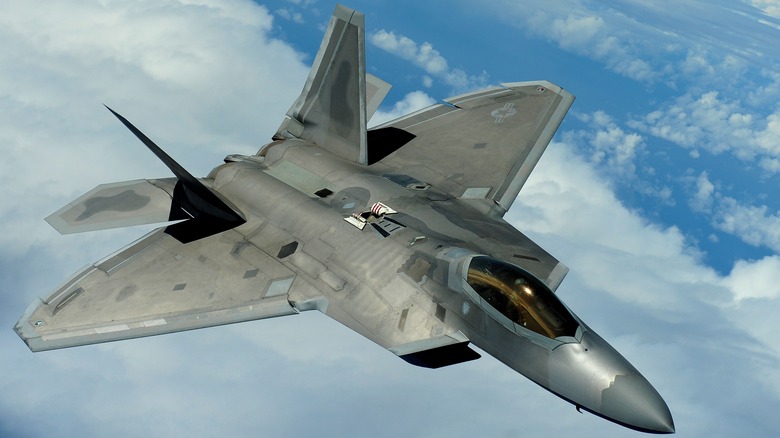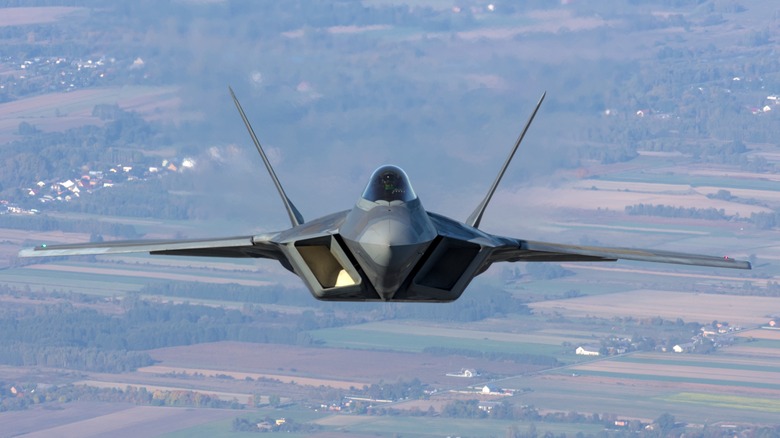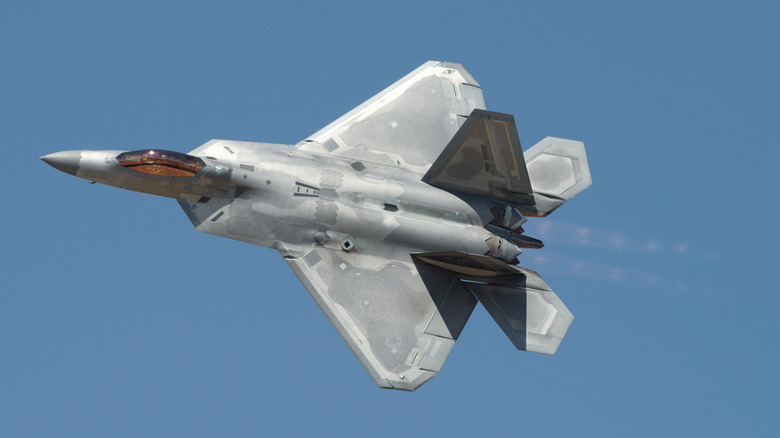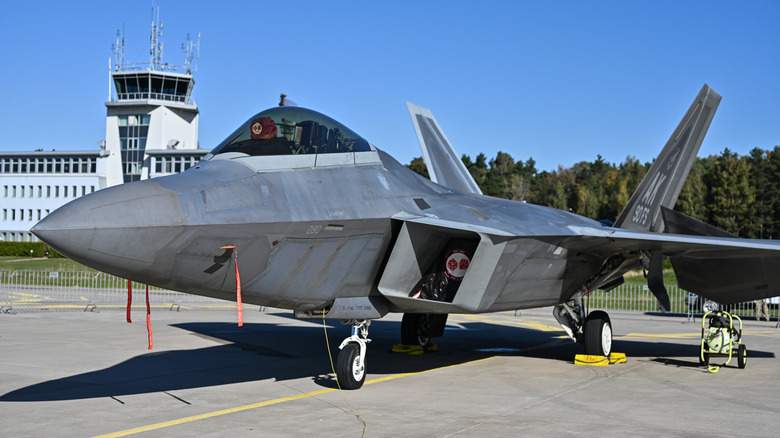Biggest Strengths And Weaknesses Of The F-22 Fighter Jet
Lockheed Martin's fifth-generation F-22 Raptor entered development in the 1980s as a replacement platform for the U.S. Air Force's F-15 and F-16 planes but with the added benefit of stealth. While the F-117 Nighthawk predated it, it was never envisioned as a fighter in the same sense as the F-22, as it was designed for dogfighting. As a result, the F-22 is the first true stealth fighter aircraft.
The F-22's construction makes it far faster and more maneuverable than the fighters before it, marking a significant advancement in Air Force capabilities. As a fighter, the F-22 boasts numerous advancements. It can reach Mach 1.5 without engaging its afterburners, saving fuel and distinguishing it from all other planes at the time. The F-22 was in development for 24 years before its first flight in 1997, and the Air Force ordered 750 of them.
Testing began in 1997 and ended in 2005 when the aircraft entered active service. Since then, the F-22 has flown numerous missions, including in 2006's Operation Noble Eagle. In 2009, it deployed to Al Dharfa Air Base in the United Arab Emirates, where it intercepted an Iranian F-4 that flew too close to a passing MQ-1 Predator. Later, the F-22 flew combat bombing missions in support of operations in Syria, and it flew missions in Afghanistan as well. To date, its only air-to-air "kills" are of wayward Chinese spy balloons found over U.S. airspace.
The F-22 — an interesting aircraft developed at a crossroads in time — has both strengths in its technological prowess and weaknesses namely in its costs.
What makes it special
As the Air Force's first true stealth fighter, much of what went into the F-22's design had to be built from the ground up, as previous stealth technologies had limited functionality. The F-22's stealth technology swapped the radar-absorbent material used in the F-117 and B-2, preferring instead carbon fiber composites, which are strong and lightweight. This mitigated the need for costly climate-controlled hangars required to house the B-2. This made the F-22 more deployable.
The aircraft's design also limits radio frequency emissions, minimizes its infrared signature, reduces its sound, and obscures its visibility to the naked eye. Even when adversary pilots could see an F-22, they couldn't get a lock on the target electronically, making it almost impossible to hit with missiles. Since the F-22 was technically built for dogfighting, this was an incredible advancement that all but guaranteed survivability in combat.
Because the F-22 is a dogfighter, it favors maneuverability over range and other considerations. The aircraft's Pratt & Whitney F119 engines can direct thrust up and down by 20 degrees, which allow for tighter turns without stalling. This level of maneuverability sets the F-22 apart, and it's paired with the AN/APG-77 Agile-beam AESA radar, which makes the aircraft incredibly difficult for anti-air radar to see.
It's an expensive program
Alas, the Air Force has fewer than 200 F-22s in operation. Cost became a major consideration, and the branch cut its initial order of 750 to a fleet of just 186. Each runs about $350 million, with the total program costing $67 billion. For comparison, the more advanced F-35B, which isn't cheap, costs $109 million per unit. Much of the overrun stems from the F-22's extended design and manufacturing time, as innovations were required to fulfill the scope of the platform's intended use.
With each added upgrade to existing technology and capabilities, the costs increased, as did production time and maintenance budget. Ultimately, the F-22 became the most expensive per-unit fighter ever built, which made it unpalatable. The platform isn't just expensive to build and maintain; its operating costs are too. To fly the F-22 for only one hour, the Air Force spends $85,325, according to Government Accountability Office data.
As time has gone on, the cost of development, production, deployment, operation, and maintenance of the F-22 has climbed, ultimately dooming the aircraft. When 186 production aircraft were completed, the project came to an end. The Air Force continues to operate F-22s, and it has plans to continue upgrading the existing fleet, but new ones won't be produced in the future.
The F-22 as a legacy fighter
The F-22 has a limited range compared to its peers. It has a combat range of 600 miles, which sounds like a lot, but it limits the aircraft's deployability to some parts of the world. For comparison, the F-35's range is slightly further at 678 miles. And while the F-22 has advanced stealth tech, it's not incredibly durable. While flying over Syria, the aircraft began shedding its radar-absorbing coating in 2019.
When the F-22 entered the design phase, it was planned as a replacement fighter aircraft with incorporated stealth technology. By the time it rolled off the assembly lines, warfare had already changed significantly, and the age of dogfights, which the F-22 was purpose-built for, was essentially over. It's never shot down a single enemy aircraft. While it's a highly capable dogfighting platform that functions well in combat, it's more expensive and does have a lack of versatility compared to the follow-on F-35.



